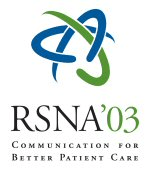Abstract:
HTML
Purpose: We evaluated the usefulness of cerebral perfusion CT (PCT) for the monitoring of tissue reperfusion and the prognostic value in patients with thrombolysis therapy.
Methods and Materials: 8 patients (age 63.5±17.4 yrs.) with CT workup pre (1.6±0.4 hrs. after onset of symptoms) and post thrombolysis with rTPA (36.8±27.3 hrs.) consisting of nonenhanced CT (NECT), PCT at the level of basal ganglia and CT angiography were included. Color coded perfusion maps - cerebral blood flow (CBF), cerebral blood volume (CBV), time to peak (TTP) - were calculated. The size and relative perfusion values (rCBF, rCBV, rTTP) were measured in the different perfusion maps for the ischemic center (IC) and the area of total ischemia (TI) respectively in the pre and post thrombolysis examinations. The final size of infarction was measured in the follow-up NECT. Clinically, the mean National Institute of Health Stroke Scale (NIHSS) score was 13.63±4.81 on admission and 5.88±4.55 on discharge.
Results: The initial PCT revealed a mean size of the TI of 22.58±10.99 cm2 and of the IC of 6.16±3.65 cm2. Before thrombolysis, the rCBFTI (0.57±0.19) and the rCBFIC (0.30±0.20) as well as the rCBVTI (0.70±0.20) and the rCBVIC (0.40±0.24) demonstrated reduced perfusion, in paticular of the IC. After thrombolysis, the rCBFTI (1.16±0.38) and the rCBVTI (1.16±0.32) were increased indicating tissue hyperperfusion. The final infarct size in the follow-up CT scan was 7.16±5.64 cm2. The regression analysis revealed the size of CBVIC in the initial PCT for the best predictor of final extent of infarction (r=0.834). The mean improvement of the NIHSS score during therapy was -7.75±3.28. The rCBVTI of the initial PCT demonstrated to have the best correlation with the NIHSS score improvement during therapy (r=0.792).
Conclusion: PCT allows the monitoring of thrombolysis therapy in acute stroke in terms of tissue reperfusion. The size of the CBVIC correlates well with the final extent of infarction after thrombolysis. Moreover, the rCBVTI has the best prognostic value for the neurological improvement after successful thrombolysis.
(E. K. : Siemens, Employee (Self))
Questions about this event email: kloska@uni-muenster.de
Kloska MD, S,
Cerebral Perfusion CT for the Monitoring of Reperfusion and the Prognostic Value in Acute Stroke Thrombolysis. Radiological Society of North America 2003 Scientific Assembly and Annual Meeting, November 30 - December 5, 2003 ,Chicago IL.
http://archive.rsna.org/2003/3103627.html

